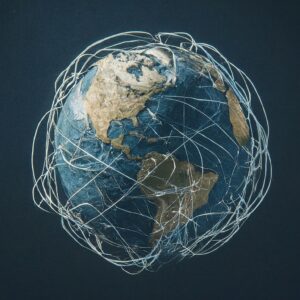Small- and medium-sized companies have smaller toolboxes than large manufacturers when it comes to de-risking their supply chains, but even the big players have endured plenty of pain over the past few years. Multinational behemoths including Toyota, Apple and Sony have struggled to meet customer demand for their products, and in many cases, semiconductor shortages have been at the center of production problems.
The components of the “perfect storm” affecting manufacturers are well-known: COVID lockdowns affecting workforce availability, shipping bottlenecks that have led to exponential freight charge increases, and for U.S.-based China manufacturers, the so-called “Trump tariffs” that have remained in place during the Biden administration. An additional factor affecting SMEs is that overseas factories often prioritize large customers over small ones, meaning that while Nike may have the leverage to get its shoes made, Klassy Kicks probably doesn’t (in fact, a major player like Nike may have already “asked” the factory to shed smaller customers, or brought on that result through production requirements that can only be achieved by focusing on the big client).
“Absurdly Vertically Integrated”
We have written extensively about the many companies working to diversify their supply chains, mostly by moving some or all of their manufacturing out of China to Vietnam or Mexico or Poland or India, but this week The Economist wrote about Tesla’s efforts to reverse the tide of supply chain outsourcing in favor of a Silicon Valley-like “full stack” value chain that pulls many supply and manufacturing elements back under the company’s control.
On an investor call in Q3 2020, CEO Elon Musk said, “Tesla is absurdly vertically integrated compared to other auto companies or basically almost any company. We have a massive amount of internal manufacturing technology that we built ourselves … It’s like, okay, what are the things we want to make, design a machine that will make that thing, then we make the machine.”
Tesla’s interest in controlling its supply chain extends to striking deals directly with mining companies that produce the raw materials vital to the production of semiconductors; the company has struck recent deals to acquire lithium, cobalt, graphite and nickel directly from the producers.
Not only does this support the development of a more reliable supply chain, but also it gives Tesla more control over the environmental and social risks of manufacturing. In its 2021 Impact Report, Tesla wrote, “Direct sourcing from mining companies allows Tesla to engage directly in local contexts instead of having to rely on multiple midstream companies that typically sit between EV makers and mining. It also enables more transparent and traceable supply chains and better environmental and social data.”
Tesla’s Strategy Is Not New
The Economist notes that Tesla’s strategy is a throwback to the time when Henry Ford purchased rubber plantations in Brazil in an effort to circumvent the British rubber monopoly. Ford also owned coal mines and steel mills.
Old Asia Hands will know that “absurdly vertically integrated” companies are alive and well in Japan and Korea, and date back to the second half of the 19th century. What were family-controlled vertical monopolies called zaibatsu in Japan are now known as keiretsu, with a board of directors at the top rather than a patriarch. The Korean equivalent are chaebols, a more recent development, but similar in structure and in large part a legacy of Japanese colonialism.
The Toyota keiretsu is associated with the Mitsubishi UFJ Financial Group, and comprises companies such as Toyota Motor Corporation, Hino Motors (trucks and buses), Daihatsu (compact cars and trucks), Aichi Steel, Toyota Industries (automotive components) and Denso Corporation (automotive components and robotics; plus, the company invented the QR code!).
Toyota group companies are focused on their main customer, which in most cases is Toyota Motor Corporation, but even “absurdly vertically integrated” companies such as Toyota have many external suppliers, some or many of which it cannot fully control.
Feeling Exposed
A recent Foreign Policy article about potential COVID-related problems for China manufacturers noted that many supply chains are too complex to fully comprehend. “‘Most companies simply have no way of knowing all the participants in their supply chain,’ said Michael Essig, a professor of supply management at Bundeswehr University in Munich, in 2019. He added, ‘Let’s assume that a global company like Volkswagen has around 5,000 direct suppliers and that each has around 250 subcontractors. That means that the company has 1.25 million second-tier suppliers. With each additional step, the supply chain grows exponentially.'”
Last August, Toyota slashed its production forecast for September due to the scarcity of semiconductors, and in December it again announced factory shutdowns due to parts shortages. Most other major auto manufacturers have also reduced production schedules because they have been unable to secure enough semiconductors. Manufacturers of computers, wireless communications devices, consumer electronics white goods, and many “Internet of things” peripheral devices have also cut production because of semiconductor shortages.
Tesla’s strategy of vertical integration seems to make sense, though, in light of raw materials and components shortages, combined with supplier unreliability. And yet, even tightly integrated Toyota has not escaped supply chain issues during COVID (and earlier, after the earthquake and tsunami of 2011 and subsequent energy shortage resulting from the shutdown of all of Japan’s nuclear reactors).
Stellantis CEO Carlos Tavares built a reputation as a corporate turnaround artist by cutting costs, and outsourcing parts manufacturing is far less expensive than building them in-house. Tavares says his company, which represents the merger of Peugeot and Fiat Chrysler, relies on external suppliers for 85 percent of its auto parts. Tesla is estimated to produce 50 percent of its auto parts in-house.
Not everyone has Tesla’s scale, and resultant capacity to throw money at problems. Elon Musk can strike deals to purchase rare earths directly from mining companies, but you can’t.
Looking at semiconductors alone, the lead time for manufacturing a new chip design is four months, if capacity is available; a more likely time frame is 12-18 months. If you want to build your own semiconductor manufacturing plant (and can get access to the raw materials and manufacturing equipment), you will probably be rolling out chips three years from now.
And even if you do have the resources to build your own semiconductor plant, you won’t be pleased to hear that analysts are questioning whether or not there are enough rare earths in the earth to meet demand. This news has prompted Tesla to begin redesigning its batteries to eliminate certain raw materials, e.g. cobalt.
What Could Possibly Go Wrong?
Many people’s first instinct is to look for short-term solutions to what they perceive as short-term problems (e.g. market downturns, trade tariffs, government-mandated lockdowns). And sure, markets will (eventually) rebound, lockdowns will (eventually) end, and we will at some point be on the other side of this crisis (and on to the next).
One problem is, we don’t know how short the short term will be. Another problem is that we don’t know what the business landscape will look like once we do get through to the other side.
SMEs should look for medium-term solutions rather than short-term ones. What should your business look like once the coronavirus crisis is past (whenever that may be!)?
If you thought to yourself five years ago, “I think we should diversify our manufacturing outside of China”, you’re sitting pretty (or at least, sitting prettier than you probably would be if you hadn’t had that thought about diversification).
But many business owners struggle to overcome “plan continuation bias”, the preference of many decision-makers to continue with an existing strategy despite changes in the conditions that justified the launch of that strategy. Many companies (not just SMEs) that “make stuff” spend a lot more time on product strategy than corporate strategy. In other words, if last year’s plan was to “make a lot of stuff”, this year’s plan is to “make more stuff”, and next year’s plan is to “make even more stuff”. Few companies are regularly rethinking basic manufacturing processes, as Tesla did when it decided to re-engineer its batteries to eliminate the need for cobalt.
Unless you’ve inherited a family-controlled vertical monopoly, you probably know that business is hard.
Of course, you need to always be closing, but in addition, you need to always be thinking, always be planning, and always be making decisions.

























